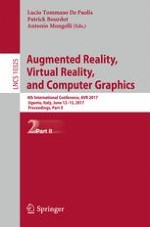2017 | Buch
Augmented Reality, Virtual Reality, and Computer Graphics
4th International Conference, AVR 2017, Ugento, Italy, June 12-15, 2017, Proceedings, Part II
herausgegeben von: Lucio Tommaso De Paolis, Patrick Bourdot, Antonio Mongelli
Verlag: Springer International Publishing
Buchreihe : Lecture Notes in Computer Science
